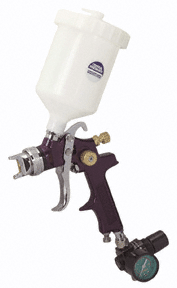Note: This article is from Jesse Wiseman Hull’s website, now archived here.
Sunday, September 30th, 2007
I prefer to spray my glazes. When done correctly, this method can create a smooth and very even coating of glaze. This way you don’t wind up looking at the piece after it is fired, wondering whether “that effect/defect” on one side is a result of a heavier or thinner application. Brushing and dipping can certainly be done with accuracy and has it’s own advantages, but spray glazing is still my preference.
When spraying, I place a piece on a banding wheel (I think Shimpo makes the best), and apply each glaze layer to the point where it stops drying… this will be just before it starts to run. I wait until the glaze sets up again (the watery sheen disappears) before spraying the next coat, so as not to distort the surface with the pressure coming out of the gun. But don’t let the layer dry completely, as you risk the first layer(s) bubbling/lifting up off the pot as it rehydrates. This “dry -but not too dry” rule applies to any application method, by the way.
Whether spraying, dipping, or brushing, I test the thickness of my glaze application with a push pin marked in millimeter increments (1-3mm) and record that in my notes. Many people use this method for testing glaze application thickness. The first time I read about this simple technique, was in the book “Ceramic Technology for Potter’s and Sculptor’s” (Cuff, 1996). John Tilton brought a depth gauge (sometimes incorrectly referred to as a micrometer ), specially machined for testing glazes, to the Peter Ilsley Workshop in 2006.

Concerning spray guns, I’ve had acceptable results with many types, but I think HVLP works best. I buy these from a place like Harbor Freight, my reason being that paint guns weren’t made to have abrasive glaze particles passing through them. In this regard, I’ve found that more expensive guns wear out just as fast under this type of (ab)use, so I buy the “cheapies” and treat them as disposable (actually, my most recent 3 have lasted over a year).
I also recommend gravity feed models… otherwise, you’ll have glaze left in the canister of the “bottom feeder” models, as they, well… don’t do all that good a job of feeding off the bottom… ![]()
Incorporating additives such as suspension agents and binders to enhance the glaze’s storage and dry handling properties is a good idea. Click here for this info.


